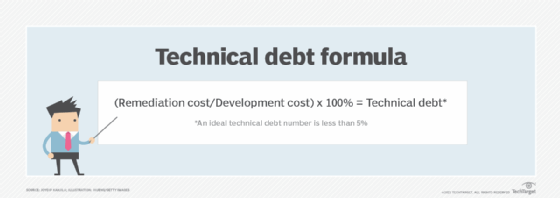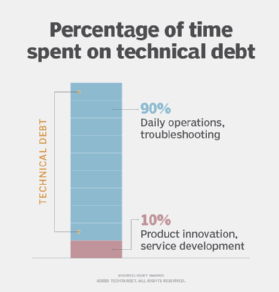
Getty Images
How to manage and reduce technical debt in Agile
Don't let technical debt snowball. Here's how to monitor, maintain and reduce this problematic element of Agile and continue application development projects.
When debt accrues, it needs to be paid back over time and usually with interest. Technical debt is no different.
When developers add functionality, scalability or interoperability to a given program, they risk racking up technical debt. For example, if developers take shortcuts to add new application features based on client demands, any problems that stem from the added functionality that require more work down the road -- such as refactoring -- is called technical debt. Technical debt in Agile development is no different. One way or another, it'll need to be paid.
Let's examine how to calculate, monitor and ideally eliminate technical debt in Agile development.
Measure and monitor technical debt
While organizations don't seek to create and compound Technical debt, it's extremely common -- and predictable. If companies wait until every line of code is perfect, projects will never leave the development stage.
However, teams can monitor and manage technical debt to find the technical debt ratio and continue with application development. For example, tools such as SonarQube and Coverity measure technical debt and provide data to calculate the technical debt ratio and keep development on time.
Once teams find their ratio, they can continue to proactively monitor and manage their development and control potential issues in the future.

Technical debt in Agile
Agile development relies on speed. Application features need to function properly to continue development. Even if the application works perfectly, teams will likely accumulate technical debt as they prioritize speed and accelerated delivery over best practices and quality assurance.

When teams scramble to meet sprint deadlines, it usually results in lengthy methods, inefficient routines or low-quality code. If teams emphasize new features over resolving bugs, it also creates a technical debt that will need a resolution before it passes to the next development step.
Agile developers must take responsibility for their work, even if it means admitting they take shortcuts to meet deadlines. Excellence and consistency are integral parts of Agile sprints, but they can come with a cost.
Monitor how much technical debt your team accrues and plan to fix it during the product backlog stage.
Costs of technical debt
Here are the four most common costs associated with technical debt in Agile development.
Low code quality. If developers rush to meet a deadline, they may do so at the expense of clean, well-organized code. Poor design and coding practices might finish the project on time, but they create long-term trouble. Developers who come along later will have to deal with those missteps, and they may struggle to maintain and monitor the codebase. The team incurs technical debt because of this poor code design, resulting in a backlog of tasks related to code cleanup.
Reduced forward motion. As technical debt accumulates, the amount of work needed to keep the project going grows proportionally. Whether it's because of code complexity, testing or any other issues, it adds time to the project that could have been fixed in an earlier stage. As a result, your developers will spend time addressing these problems rather than delivering other work with business value.
Increased defects. Defects are a common consequence of technical debt. These defects affect the customer experience and raise the product's maintenance costs throughout its lifetime.
Negative team morale. As technical debt accumulates, it becomes more challenging to comprehend the present system state and the amount of work needed to add new functionality. Technical debt can lower your team's productivity considerably. As work grinds to a halt, the team's morale will undoubtedly dip as they spend time fixing preventable problems -- hopefully without creating new ones.
How to reduce or eliminate technical debt
Several ways to reduce or eliminate technical debt include:
Automated testing. Don't waste time on manual testing; it's largely inefficient. One of the most successful ways to reduce or eliminate technical debt is automated testing. Automated testing reduces code problems because of automated debugging cycles and other processes that scan the code for problems every time a module is updated.
Project structure. One of the most efficient ways to minimize technical debt is to structure your project better. Project management tools -- such as Hive Trello – can help teams track development statuses and keep on schedule. Another way to reduce technical debt is to monitor code troubles and fix them as quickly as possible. Code-analysis tools such as Sonargraph and Klocwork can help identify these problems and prioritize them.
Establish code best practices. Organizations should prepare a coding standards document that also includes best practices for developers to follow. When your developers adhere to the coding standards and best practices, it helps reduce technical debt considerably. You can also take advantage of pair programming to produce better results.
Refactor your source code. Refactoring is another way to deal with technical debt. You can take advantage of refactoring to alter the source code's internal quality without changing the external behavior. However, refactoring aims to change poorly written code -- often referred to as filthy code -- that contributes to technical debt. This kind of code may occur due to developers' ineptitude or inexperience or their desire to provide a quick workaround. If teams refactor at regular intervals, you may decrease existing technical debt and improve your code's maintainability, readability and efficiency.
Select a scalable, flexible architecture. To avoid refactoring, teams should identify an architecture that is secure, scalable and flexible. Architecture debts are costly not just in technical debt, but also in real dollars. Examine new technologies and architectures for your platform that offers seamless integration and feature additions.
Technical debt isn't all that bad
Technical debt isn't always harmful. For example, if the development backlog consists of app improvements rather than fixing bugs, it helps push the application forward.
Still, it's preferable to avoid technical debt. When teams identify the root causes of the debt, it helps enhance development and prevent these problems in the future.







